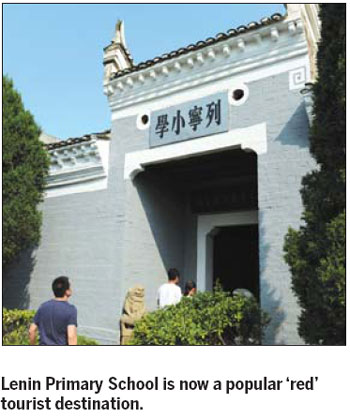| About Hubei | Culture & Arts | ||
| Attractions | Routes | ||
| Dining | Shopping | ||
| Hotels | Transportation | ||
| Entertainment | Travel agencies |
Jingshan to attract Wuhan tourists
Storytelling queen
For the love of Wuhan
Dangyang to promote tourism


Tourism fueled by 1930s 'red' sites and relics from revolution
By Zhang Zhao (China Daily)
Updated: 2013-12-17
The hometown of 43 generals since the New China was founded, Xinxian county in Henan province is turning its history of revolution into tourism resources.
During the late 1920s and 1930s, the county was the second-largest communist base in China where three major branches of the Red Army grew.
It is also where the Red Army began an air force by capturing its first plane.

Many of the red relic sites are well preserved today, including offices, command posts and the residences of former army leaders.
The former Party committee and the Soviet government for Henan, Hubei and Anhui provinces was located in compounds in the county that before belonged to local landlords.
The buildings preserve a typical architectural style of the Qing Dynasty (1644-1911).
The cemetery park for General Xu Shiyou (1905-1985) was opened to the public just recently. It is built around his former residence on the mountainside in Hepu village.
The residence was restored to keep its original style and structure, with very humble furniture and decorations.
Some of the furniture was used by Xu and his family some 80 years ago, but some comes from neighboring homes to show the local lifestyle at that time.
A hole in the wall of the kitchen leads to a path up the mountain, which Xu once used to escape from an enemy roundup in his early revolutionary career. It has been kept there ever since.
Sidian township, the hometown of Lieutenant General Zheng Weishan (1915-2000), is another tourist destination with a number of red sites including Jiangjunshi, a giant rock where Zheng's remains are buried, and a pool where local people hid weapons for the Red Army.
There is also the memorial museum completed in April 2010 to commemorate the Fourth Red Army, which was developed from just a few score guerrillas into a regular troop of 80,000 soldiers.
Hu Mian, head of the Sidian township government, told China Daily that they are building Sidian into a "small town with distinct southern Henan flavor" and red-themed tourism is leading the development of the local service industry.
He said the township has more than 40 farmhouse restaurants, seven of them with annual revenues of 400,000 yuan ($65,880). The sector has provided more than 2,000 jobs to locals and generates extra yearly income in excess of 2,000 yuan for each household on average.
The hospitality industry is like "a robust factory without smoke", said Hu as it contributes 40 percent of local taxes.
The county government is planning a pilot tourism route from the county center to the Jiangjunshi scenic area, with some 20 km of the route in Sidian.
This year the township initiated a program to grow more than 100 hectares of rape along the route so that every May more tourists will be attracted by the vast field of small, yellow flowers.
They will also integrate resources and fund upgrades in infrastructure at a number of tourist attractions along the route including dams, bridges, pools and roads connecting each village. The project will start at the beginning of next year.
Investment from around the world is welcomed, Hu said.
Beside improvements to revolution relic sites, Hu said the local government will collect stories from the 10 generals who were born in the township, hoping the sagas will also attract tourists.
Traditional local culture and customs, which combines features of Henan and Hubei provinces, will also be an attraction.
Some farmhouses around the Jiangjunshi area will be open to tourists, allowing them to experience traditional Chinese farming culture.
"Coaches will instruct them how to turn a millstone, grow vegetables or weave cloth," Hu said. "There, tourists will better understand the real countryside life."
zhangzhao@chinadaily.com.cn
(China Daily 12/17/2013 page18)